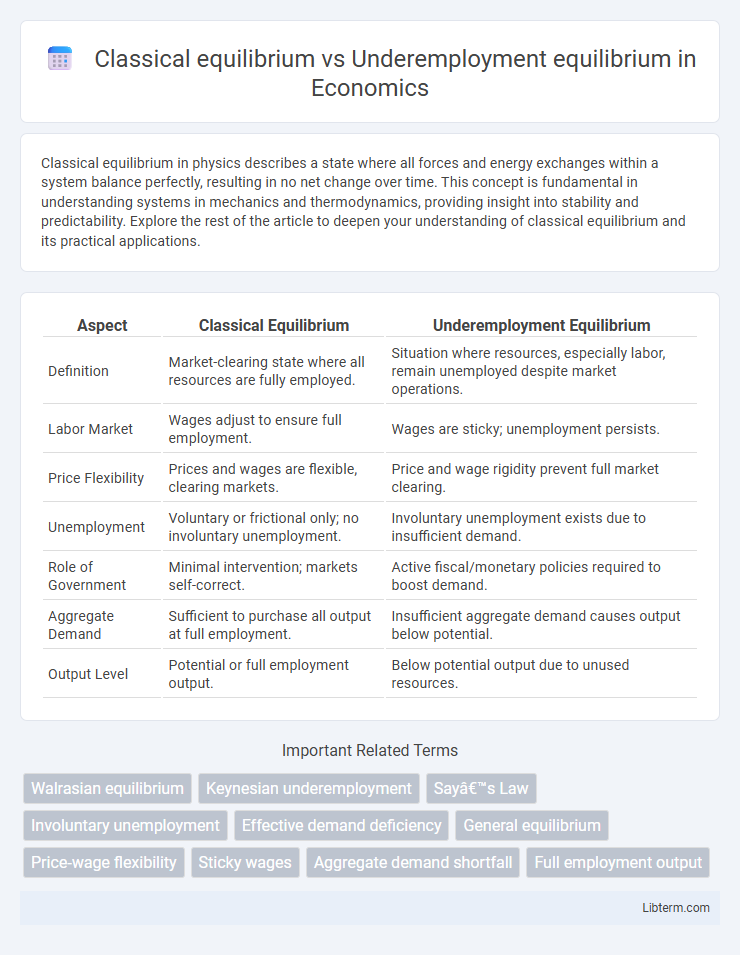Classical equilibrium in physics describes a state where all forces and energy exchanges within a system balance perfectly, resulting in no net change over time. This concept is fundamental in understanding systems in mechanics and thermodynamics, providing insight into stability and predictability. Explore the rest of the article to deepen your understanding of classical equilibrium and its practical applications.
Table of Comparison
| Aspect | Classical Equilibrium | Underemployment Equilibrium |
|---|---|---|
| Definition | Market-clearing state where all resources are fully employed. | Situation where resources, especially labor, remain unemployed despite market operations. |
| Labor Market | Wages adjust to ensure full employment. | Wages are sticky; unemployment persists. |
| Price Flexibility | Prices and wages are flexible, clearing markets. | Price and wage rigidity prevent full market clearing. |
| Unemployment | Voluntary or frictional only; no involuntary unemployment. | Involuntary unemployment exists due to insufficient demand. |
| Role of Government | Minimal intervention; markets self-correct. | Active fiscal/monetary policies required to boost demand. |
| Aggregate Demand | Sufficient to purchase all output at full employment. | Insufficient aggregate demand causes output below potential. |
| Output Level | Potential or full employment output. | Below potential output due to unused resources. |
Introduction to Economic Equilibria
Classical equilibrium describes a market state where supply equals demand, ensuring full employment of resources and price stability, based on flexible wages and prices. Underemployment equilibrium occurs when the economy operates below full employment due to rigid wages or insufficient demand, leading to persistent unemployment and unused capacity. Understanding these economic equilibria is essential for analyzing labor market dynamics and the effectiveness of fiscal and monetary policies.
Defining Classical Equilibrium
Classical equilibrium occurs when labor markets clear at the natural rate of unemployment, meaning supply equals demand without involuntary unemployment. In this state, wages and prices adjust flexibly to ensure full employment and optimal resource allocation. Underemployment equilibrium, in contrast, is characterized by persistent involuntary unemployment due to rigid wages or market imperfections preventing labor market clearing.
Understanding Underemployment Equilibrium
Underemployment equilibrium occurs when an economy settles at a level where resources, especially labor, are underutilized, resulting in unemployment despite available jobs. This contrasts with classical equilibrium, which assumes markets clear with full employment and flexible wages. Understanding underemployment equilibrium highlights structural inefficiencies and wage rigidities that prevent the labor market from reaching full employment, making it a critical concept in Keynesian economics.
Key Assumptions of Classical Theory
Classical equilibrium hinges on the assumption of flexible wages and prices ensuring full employment in the labor market, where supply equals demand. It presumes rational agents with perfect information and markets that clear without involuntary unemployment. Underemployment equilibrium challenges these assumptions by highlighting wage rigidities and market imperfections leading to persistent unemployment despite available labor supply.
Causes of Underemployment Equilibrium
Underemployment equilibrium occurs when aggregate demand is insufficient to achieve full employment, causing persistent unemployment despite available labor resources. This situation arises from factors such as wage rigidity, insufficient consumer spending, and weak investment demand, which prevent the labor market from clearing. Unlike the classical equilibrium where flexible wages ensure full employment, underemployment equilibrium is characterized by involuntary unemployment due to demand deficiencies and market imperfections.
Major Differences: Classical vs Underemployment
Classical equilibrium assumes full employment where all available labor resources are efficiently utilized, reflecting a market-clearing wage that balances supply and demand. In contrast, underemployment equilibrium occurs when wage rigidity or other market imperfections lead to persistent unemployment despite excess labor supply. The major difference lies in the Classical model's belief in self-correcting markets that prevent unemployment, whereas the underemployment equilibrium acknowledges structural or demand deficiencies causing labor market disequilibrium.
Role of Wage and Price Flexibility
Classical equilibrium assumes wage and price flexibility that enables labor markets to clear, eliminating unemployment by allowing wages to adjust to equate labor supply and demand. Underemployment equilibrium, however, occurs when wage and price rigidities prevent markets from clearing, resulting in involuntary unemployment despite available labor supply. The key difference lies in the price and wage flexibility's ability to restore full employment in classical models, which is absent in underemployment scenarios.
Policy Implications: Classical vs Underemployment
Classical equilibrium suggests that labor markets clear automatically, implying minimal government intervention is needed, as wages adjust to eliminate unemployment. Underemployment equilibrium highlights persistent involuntary unemployment due to rigidities like wage stickiness or insufficient demand, necessitating active fiscal and monetary policies to stimulate job creation. Policy implications differ fundamentally: Classical theory favors laissez-faire approaches, while underemployment equilibrium supports targeted government action to achieve full employment and economic stability.
Real-World Examples and Case Studies
Classical equilibrium occurs when labor markets clear, wages adjust freely, and unemployment is minimal, as seen in the U.S. economy during the 19th century industrial boom. Underemployment equilibrium, characterized by persistent unemployment despite wage flexibility, is evident in developing countries like India, where surplus labor and job mismatch cause chronic underemployment. Case studies from the Great Depression highlight how rigid wages and demand shortfalls can trap economies in underemployment equilibrium, contrasting with periods of full employment in post-World War II Europe where classical equilibrium was more closely achieved.
Conclusion: Bridging the Equilibrium Gap
Classical equilibrium assumes full employment with flexible wages and prices ensuring market clearance, while underemployment equilibrium reflects persistent unemployment due to rigidities and insufficient demand. Bridging the equilibrium gap requires policies addressing structural unemployment, wage inflexibility, and demand shortfalls to achieve a more efficient labor market outcome. Effective interventions promote resource utilization and economic stability by aligning classical theory with real-world complexities.
Classical equilibrium Infographic

 libterm.com
libterm.com